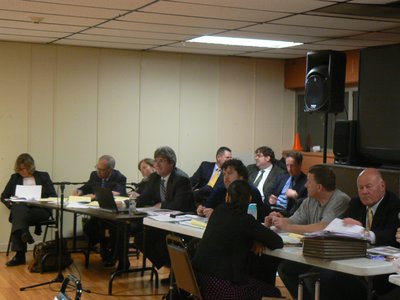Hearings resumed before the Hoboken Planning Board on Wednesday regarding the city’s proposed Southwest Redevelopment Plan. Residents have been turning out to give opinions about what kind of development should be built on 17 acres near the city’s southern entrance. While many people want to see parks and other vibrant development constructed there, some are concerned that a few working businesses and historic structures may be demolished.
Wednesday’s hearing gave the public their first chance to comment since the Hoboken Planning Board released their Southwest Redevelopment Study, a 128-page document prepared by Clarke Caton Hintz that makes recommendations about whether portions of the city’s southern entrance meet the criteria for redevelopment.
The study says that 74 percent of the properties in the zone meet the criteria, including areas with unsafe, unsanitary, or dilapidated buildings, or lots that have been destroyed due to natural disaster. The bulk of the properties in the area include parking lots or small industrial or commercial businesses. If the area is designated for redevelopment, the city has the power to rezone the land, acquire property (sometimes through eminent domain), clear it, solicit bids from developers, and more.
Residents, members of the council, and attorneys crowded the multiservice center at 124 Grand St. for a three-hour meeting.
The next hearing, which was actually scheduled for the night after the Wednesday hearing, had to be postponed until traffic reports can be reviewed by attorneys. A new date had not been set by press time.
Historic firehouse
One resident, Elizabeth Adams, expressed her disappointment with the study’s inclusion of an old firehouse at 55 Madison St. At a hearing two weeks ago, a planner said the structure should be included in the redevelopment process.
“Please don’t tear this place down,” said Adams. “This is a cute building. This is a historic building.”
“With the recent fires we’ve had here,” continued Adams, “theoretically we need more firehouses in this town. We don’t need fewer; we need as many as [possible].”
“I would really hate to lose my business. I’ve been in the building forever.” – River Clark
__________
Property 19
The majority of the feedback was dedicated to a lot deemed “Property 19,” which is situated between Harrison and Jackson Streets directly south of Observer Highway. Only a portion of the property meets the criteria for development, according to the study, and many residents took exception to the three buildings that are included.
Several young business owners expressed their disappointment. River Clark, the owner of the large downtown film studio “The Pudding Factory,” said his business occupies roughly 12,000 to 15,000 square feet and has been featured in nearly every major magazine.
“I’m a little broken up,” said Clark. “I would really hate to lose my business. I’ve been in the building forever.”
He added later, “I’ve had Martha Stewart in the building.”
The study lists the conditions of the building as “overcrowded.” It also says that the building’s proximity to Newark Street is hazardous.
“The building’s relationship to Newark Street creates a chaotic space where vehicles and pedestrians must jockey with each other,” the study says, adding that vehicles often must back out into the road to exit.
The study also says that 1,810 and 1,940 vehicles travel past the property along Newark Street during a.m. and p.m. peak hours, respectively.
“The Planning Board’s function is simply to determine whether or not the properties in question either satisfy or don’t satisfy the criteria,” said Planning Board Attorney Ronald Morgan. “There’s no decision as to the use of the property by the Planning Board. That’s not the purpose of the hearing tonight.”
“None of us here know how that would pan out,” continued Morgan. “This [study] is just an application of statutory criteria, and that’s it.”
Other residents said eliminating small businesses in the area could only worsen the unemployment problem. In fact, many residents expressed the general opinion that the traffic issue could be resolved through simple construction changes rather than a complete redevelopment.
Some residents expressed the consensus that a few additional traffic lights could help curtail some of the congestion and accidents that have typically occurred in the area over the years.
“Traffic lights would probably be more of a [help],” said resident Brian Carmouche. “That is more so the issue at hand.”
Clark said that he had been in his building in Property 19 for 12 years and had never been involved in an accident.
“I’d love to see all the accidents you guys are talking about,” Clark continued, referring to the study. “I’m sure they’re not from people backing up [from property 19]. I’m sure they’re from the intersection.”
Background
After the hearings, the next step is for the Planning Board to follow the results to the City Council, which can then vote on a resolution designating the area in need of redevelopment. The council can prepare a plan and submit it to the Planning Board for review, or direct the board to prepare a redevelopment plan by resolution.
The council can then adopt the plan by ordinance, which would effectively change the zoning of the area.
The redevelopment process initially began in 2006, but was stalled after five 4th Ward residents successfully sued in Superior Court to stop the process, citing Planning Board hearing technicalities and concerns about potential overdevelopment.
Mayoral elections and other matters stalled the progress until October of 2009, when the city authorized a new study.
Stephen LaMarca may be reached at slamarca@hudsonreporter.com.
